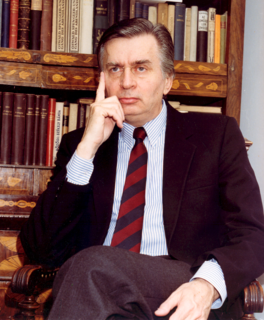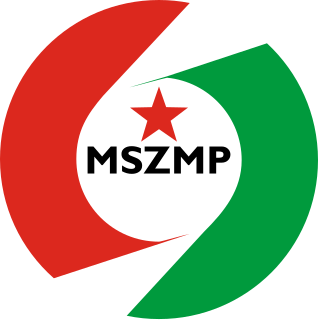
The Hungarian Workers' Party is a communist party in Hungary led by Gyula Thürmer. Established after the fall of the communist Hungarian People's Republic, the party has yet to win a seat in the Hungarian parliament. Until May 2009 it was a member of the Party of the European Left.

Parliamentary elections were held in Hungary on 7 April 2002, with a second round of voting in 131 of the 176 single member constituencies on 21 April. Although Fidesz remained the largest party in the National Assembly despite receiving fewer votes than the Hungarian Socialist Party, the Socialist Party was able to form a coalition government with the Alliance of Free Democrats.

Parliamentary elections were held in Hungary on 10 May 1998, with a second round of voting in 175 of the 176 single member constituencies on 24 May.

The 1990 Hungarian parliamentary elections were held in Hungary on 25 March 1990, with a second round of voting taking place in all but five single member constituencies on 8 April. They were the first completely free and competitive elections to be held in the country since 1945, and only the second free elections in the country's history. The conservative, nationalist Hungarian Democratic Forum (MDF) beat the liberal and more internationalist Alliance of Free Democrats, which had spearheaded opposition to Communist rule in 1989, to become the largest party in parliament. The Hungarian Socialist Party, the former Communist party, suffered a crushing defeat, winning only 33 seats for fourth place.
A four-part referendum was held in Hungary on 26 November 1989. Voters were asked whether the President should be elected after parliamentary elections, whether organisations related to the Hungarian Socialist Workers' Party should be banned from workplaces, whether the party should account for properties owned or managed by it, and whether the Workers' Militia should be dissolved. All four proposals were passed, the first narrowly by 50.1% of voters, and the remaining three by 95% of voters. Voter turnout was 58.0%.

Parliamentary elections were held in Hungary on 25 and 26 January 1920. However, they were only held in 164 districts. After the Treaty of Trianon was signed, the 44 districts previously occupied by Romania voted between 13 June and 5 July, whilst the 11 districts occupied by Serbia did not vote until 30 and 31 October 1921. The election was held with compulsory voting. In protest at this and other changes to the franchise that left 60% of the voting age population unable to vote, the Hungarian Social Democratic Party boycotted the elections, and called for its supporters to cast invalid votes, resulting in an unusually high number of blank or invalid votes - 11.8% in the January elections and over 20% in Budapest and other major cities.

Parliamentary elections were held in Hungary between 28 May and 2 June 1922. The result was a victory for the Unity Party, which won 140 of the 245 seats in Parliament, the vast majority in "open" constituencies where there was no secret ballot.

Parliamentary elections were held in Hungary between 8 and 15 December 1926. The result was a victory for the Unity Party, which won 161 of the 245 seats in Parliament. István Bethlen remained Prime Minister.

Parliamentary elections were held in Hungary between 28 and 30 June 1931. The result was a victory for the Unity Party, which won 149 of the 245 seats in Parliament. István Bethlen remained Prime Minister, but resigned on 24 August due to the effects of the Great Depression and was replaced by Gyula Károlyi.

Parliamentary elections were held in Hungary between 31 March and 7 April 1935. The result was a victory for the Party of National Unity, which won 164 of the 245 seats in Parliament. Gyula Gömbös remained Prime Minister.

Parliamentary elections were held in Hungary on 28 and 29 May 1939. The result was a victory for the Party of Hungarian Life, which won 181 of the 260 seats in Parliament. Pál Teleki remained Prime Minister. It won 72 percent of the parliament's seats and won 49 percent of the popular vote in the election. This was a major breakthrough for the far-right in Hungary.

Parliamentary elections were held in Hungary on 17 May 1953. As would be the case with all elections for the remainder of Communist rule, voters were presented with a single list from the Communist Hungarian Working People's Party, comprising Communists and pro-Communist independents. The Working People's Party won 206 of the 298 seats, with the remaining 92 going to independents.

Parliamentary elections were held in Hungary on 16 November 1958. They were the first elections held after the Hungarian Revolution of 1956. The Communist Hungarian Working People's Party had been reorganized as the Hungarian Socialist Workers' Party, under the leadership of a more moderate Communist, János Kádár. However, as was the case during the era of Mátyás Rákosi, voters were presented with a single list of Communists and pro-Communist independents. The Socialist Workers' Party won 276 of the 338 seats, with the remaining 62 going to independents.

Parliamentary elections were held in Hungary on 19 March 1967. The Hungarian Socialist Workers' Party was the only party to contest the elections, and won 259 of the 349 seats, with the remaining 90 going to independents selected by the party. Of the 349 constituencies, only nine had more than one candidate.

Parliamentary elections were held in Hungary on 25 April 1971. The Hungarian Socialist Workers' Party was the only party to contest the elections, and won 224 of the 352 seats, with the remaining 128 going to independents selected by the party. Of the 352 constituencies, only 49 had more than one candidate.

Parliamentary elections were held in Hungary on 15 June 1975. The Hungarian Socialist Workers' Party was the only party to contest the elections, and won 215 of the 352 seats, with the remaining 137 going to independents selected by the party. Of the 352 constituencies, only 34 had more than one candidate.

Parliamentary elections were held in Hungary on 8 June 1980. The Hungarian Socialist Workers' Party was the only party to contest the elections, and won 252 of the 352 seats, with the remaining 100 going to independents selected by the party. Of the 352 constituencies, only fifteen had more than one candidate.

Parliamentary elections were held in Hungary on 8 June 1985. The Hungarian Socialist Workers' Party was the only party to contest the elections, and won 288 of the 387 seats, with 98 of the remaining 99 going to independents selected by the party, whilst one seat remained unfilled until the following year.
The Party of Independence and '48, also known mostly by its shortened form Independence Party, was one of the two major political parties in the Kingdom of Hungary within Austria-Hungary, along with the Liberal Party then National Party of Work. During its existence, the F48P strongly opposed the Austro-Hungarian Compromise of 1867. The party was revived after the fall of the Hungarian Soviet Republic and restoration of the monarchy.

The Hungarian Independence Party was a political party in Hungary in the period after World War II.















